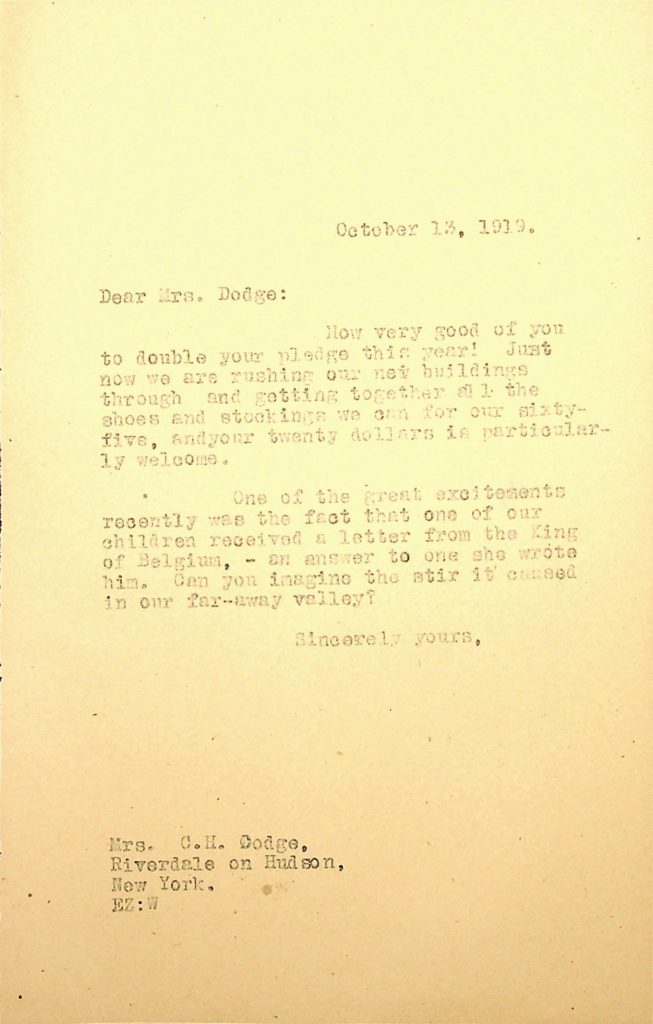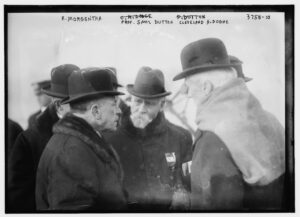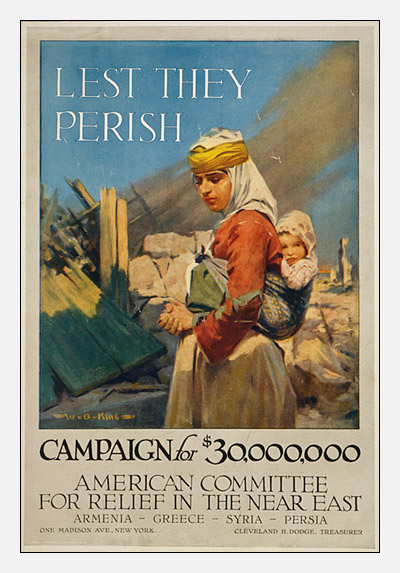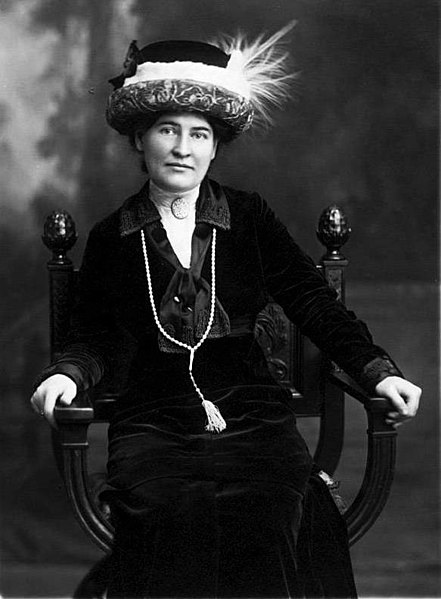THE POWER OF EMPATHY
Pine Mountain Settlement School
DANCING IN THE CABBAGE PATCH
The Power of Empathy
Series 08: ADMIN General Correspondence 1919
World War I

Copy of thankyou letter to Mrs. Cleveland Hoadley Dodge from Ethel DeLong Zande, PMSS [cleveland_hoadly_012.jpg]
THE POWER OF EMPATHY
TAGS: Ethel de Long, correspondence with donors, World War I, WWI, student correspondence, King Albert I of Belgium, Leon Deschamps, Mrs. Cleveland Hoadley Dodge, Father Anton Docher, Native Americans, Pueblo Isleta, Willa Cather, Phelps Dodge Inc., philanthropy, Riverdale Neighborhood House, Agrarian Myth, Settlement Movement
The Letter, October 13, 1919
A copy of a small fund-raising letter from October 13, 1919, in the archive at Pine Mountain Settlement School captures the broad outreach of the School during its formative years. It is a startling letter in its brief but hidden details. The letter, one of many institutional solicitations and thank you’s that went out to various donors in the early years of the institution, has a deeper history than a first view may suggest.
The steady stream of brief letters in the early years were critical in building and sustaining the Settlement School. Letters were sent to donors by the School office, by the directors, and by staff. Today these letters inform us of the close attention the Administration, students, and workers at the School gave to the world outside the boundaries of the institution and the long-isolated valley of the Pine Mountain. In 1919 the world was at war. The War effort in the first decade of the nineteenth century was underway but, remarkably, not so far away as one might think.
Addressed to Mrs. C.H. Dodge (Grace Parish Dodge [1850-1949]) at Riverdale on the Hudson, New York, and dated October 13, 1919, the brief letter thanks Mrs. Dodge for her recent pledge to the School and tells her of the work underway on the new buildings for the Settlement School. The author of the brief acknowledgment letter is “EZ”, or Ethel de Long Zande, founder and co-director of the School during that time. In her brief letter, she tells Mrs. C.H. Dodge (Grace Parish Dodge) that the School is busy getting shoes and stockings together for all the sixty-five students in attendance. She says that they are very appreciative of the $20 dollar donation. Importantly, she comments on a letter written by one of the children at the School.
Mrs. C.H. Dodge is Grace Parish Dodge, the wife of Cleveland Hoadley Dodge , and part of the N.Y. Dodge family, one of the wealthiest families in the Riverdale, New York community and in the country at the time. Cleveland Hoadley Dodge had holdings in the Pacific Railroad, the early Citibank of N.Y and other major investments. He was a close friend of President Teddy Roosevelt family as well as President Woodrow Wilson and Dodge was among the ranks of the leading philanthropists in New York, as seen in this 1916 photograph.

Cleveland Hoadley Dodge. (2023, June 25). In Wikipedia. https://en.wikipedia.org/wiki/Cleveland_Hoadley_Dodge
Mrs. Zande in her brief acknowledgment letter to Mrs, C.H. Dodge describes a recent exciting event at Pine Mountain Settlement for Mrs. Dodge. The event involves a young student at the school who was inspired by recent world events. The student (a girl, not named) wrote to the King of Belgium, Albert I, about the war. Most likely the student was inspired by the anxiety and patriotism of Leon Deschamps, a Pine Mountain worker who had recently settled in the United States from Belgium and was working at Pine Mountain Settlement. The young girl was moved by her admiration of Mr. Deschamps and the desire to try to help with the war effort by writing a letter to the King of Belgium. We may never know what the letter said, but we do know the chain of events it set into motion.
The child’s letter remarkably found its way to King, Albert I, of Belgium. The King, or certainly his staff answered the young student. Whe she received an answer from King Albert I it created a sensation at Pine Mountain. When the answer from the King was received, it, in fact, animated the full Pine Mountain community and led Mrs. Zande to remark about the event to her New York friend Mrs. Cleveland Hoadley Dodge (Grace Parish Dodge),
“Can you imagine the stir it caused in our far-away valley?”
Unfortunately, the letter from the young girl and that of King Albert I cannot be found in the Archive. Nonetheless, the record of the correspondence alone is extraordinary and stirs the imagination. The story surrounding the letter of 1919 was not just a simple exchange of letters. It has a deeper history.
The Deeper Story: King Albert I and Father Anton Docher
1919 was the year that Belgian ruler, King Albert I, visited the United States. From September 23 through November 13, the King, his Queen, Elisabeth of Bavaria, and their son Prince Leopold II made an official visit to the United States. Their American visit included a trip to a small Native American pueblo in New Mexico, the Pueblo Isleta. There, the King honored Father Anton Docher, a hero of early World War I. The homage centered, particularly, on Father Anton’s work in the Belgian Congo. The King was intent on bestowing on the Priest the insignia of Knight in the Order of Leopold II and the French Colonial Medal, for his war courage and service to Belgium.
Anton Docher, the focus of the award, left the War and the Congo a changed man. He soon studied for the priesthood. During the remainder of his life, Father Anton asserted that colonialism was an international evil, and he committed his life to serving and learning from various Native tribes in New Mexico about their oppression as Native Americans. By all accounts, the Belgian-New Mexico ceremony to honor Docher was no small event, as some ten thousand people reportedly came to attend the ceremony in the small Pueblo Isleta.
Father Docher also did not escape the attention of the writers of his day, including the noted author, Willa Cather. Father Docher as the model for her well-received novel, Death Comes for the Archbishop (New York: Alfred Knopf, 1927). The newspapers were full of the events of the King’s visit. They describe his journey to New Mexico, and his how his entourage traveled to New York, where the King was honored with membership in the New York Society of the Cincinnati. He was also given a ticker-tape parade and an introduction to the leading families of the city of New York. It was this New York journey that brought the King into the social circle of the Dodge family with whom Ethel de Long Zande had connections. The New York connection with the Dodge family prompted Ethel to give the subtle nudge in October 13, 1919, to Mrs. Cleveland Hoadley Dodge in Riverdale, New York.

“Lest They Perish: Campaign for $30,000,000. American Committee for Relief in the Near East.”[Genocide_poster_USA.jpg]
The Dodge Family
The Cleveland Hoadley Dodge family was a well-known and highly regarded family in New York. They moved among many of New York’s notable families of wealth. Cleveland Hoadley Dodge had built his fortune in copper mining and was a major player in the financial and social support of WWI efforts. Cleveland H. Dodge was also an executive at Phelps Dodge, a leading copper mining corporation in the U.S. that had been co-founded by his grandfather in 1832. His family was known for its generous philanthropy, and today the Dodge family continues to support the foundation he established in 1917, the Cleveland H. Dodge Foundation.
One of the central Foundation interests is its continued good work today in educational support, community programs, and cultural institutions, though mainly centered in New York. The father of Cleveland H. Dodge, William Hoadly Dodge, and his mother, Sarah Dodge, were the inspiration for their son’s philanthropy. But it was Cleveland Hoadley Dodge’s wife Grace Wainright Parish Dodge (1856-1949) , who had the connection with Pine Mountain.
GRACE WAINRIGHT PARISH DODGE
Grace was born in France but was known to be deeply connected to the Settlement Movement in America, begun by Jane Addams. As the wife of Cleveland Hoadley Dodge, her life of wealth made her strongly sensitive to the growing divide of wealth and poverty in their city of New York and in the world, and the many and growing populations displaced by war. Grace Parish Dodge was a pioneer in women’s rights and education and was the first woman to serve on the New York Board of Education, where she generously funded the New York Public Library.
Her connection to the Settlement Movement of Jane Addams and the work with the Cleveland H. Dodge Foundation, and the larger Phelps Dodge Foundation, helped to further her earlier work at the Riverdale Neighborhood House. Grace began the Riverdale House as a neighborhood library at the early age of sixteen and helped to expand its service from the early beginning. Even today, in an expanded form, the House and Library continue to provide services to Riverdale, New York, and its surrounding communities.
World War I and Pine Mountain Settlement School. The Cleveland H. Dodge Foundation established in 1917
Literacy and a remarkable push for optimism were ideas close to the heart of Ethel de Long Zande and Katherine Pettit. The early novels of Willa Cather — Oh, Pioneers! (1913), The Song of the Lark (1915), and My Antonia (1918) — were all written during the early period of Pine Mountain’s development and were well known to the two founders and their students. The ages of all the women were similar, as were their interests. Like Katherine Pettit and Ethel de Long Zande, Willa Cather had a deep and close attachment to the land. Writing in 1918, she notes
In the course of twenty crowded years one parts with many illusions. I did not wish to lose the early ones. Some memories are realities, and are better than anything that can ever happen to one again.
A strong optimism shines through the many connected lives that are called to attention by these related letters. Many of the letters from Pine Mountain during this difficult war-time period, including that of the young student sent to the King of Belgium, and the brief exchange with Mrs. Grace Parish Dodge, clearly evidence this optimism.
TRANSFORMATION AND ELEMENTS OF THE AGRARIAN MYTH

Willa Sibert Cather, Wearing a necklace given her by author Sarah Orne Jewett, another Agrarian at heart. [Public Domain, wikisource.org]
Many of the workers who came to Pine Mountain came with a romanticized vision of what has come to be called the “Agrarian Myth.” It carries many of the markers of the Settlement Movement, the Community Life Movement, and other cooperative organizations that challenged conflict, poverty, and human indifference to education and the challenges that accompany immigration and migration. The myth, the movement, and the diverse challenges blended into one as the nation went to war, and later, when they sought to heal the wounds of war. Many citizens carried their personal experiences of the challenges and horrors of WWI and life during wartime in countries “acrost the sea,” (as Uncle William would say), with them to the remote mountain School. The personal narratives of some of the workers set the imaginations of the students racing. Ultimately, what all the workers and the students held in common was a worldview — something outside their known experiences. Hope took its image from the land and its people. It was a starting place for all. The hope for a better future rests in that awareness of a shared place with diverse dreamers.
The integrated experiences, the personal relationships, the kindnesses, the honor, social justice, and the hopes of all bound many lives together during the formative years of Pine Mountain Settlement School. These shared experiences exploded narrow and protected mountain lives in a manner that is difficult to describe to today’s electronic youth, separated as they often are from the tangible present and often isolated by their electronic entertainment world. The sensitive understanding and acceptance of larger social forces encountered by those “outsiders” who passed through the Kentucky settlement deep in the hills of Appalachia were a remarkable force in transforming the lives of many children. The stability and optimism of PMSS School during the two Great Wars are all the more remarkable when placed against the enormous disintegration of the world outside the Pine Mountain Valley during those Wars and the great price paid by so many soldiers from Eastern Kentucky.
Many of the staff had seen the rubble of Europe in their early wars; the broken soldiers, and a world recovering from vicious privation and violence. Those same individuals were living within a community that knew many similar social violations through a very intimate history of feudings and the even more senseless personal violent gun history.
Though isolated, the lessons and values learned in wartime and equally through the local “feudalists” encounters, continue to remain a part of the Pine Mountain community’s history and psyche. The lessons that were learned from war and feuds are certainly embedded deeply in families who passed through the School in the Pine Mountain valley, and today continue to resonate in families in other valleys throughout the world.
War ignores borders, but compassion also does not have borders. Throughout today’s world, nation, person, and psyche, there is hate, fear, terror, and cruelty of many types. But there is also love, compassion, joy, and friendship. In these overlapping emotions, what are the change agents that bring us to war? What brought a world leader to respond to a young girl in the mountains of Eastern Kentucky? How did that letter change the young girl? Why are similar echoes so seldom heard in today’s news, even with our rapid communication?
Today’s world cannot be easily explained away by our rapid communication and our crowded lifestyles. The lessons of institutions such as Pine Mountain Settlement School, the Riverdale Neighborhood House, and in communities such as Puebla Isleta, in authors such as Willa Cather, and the kind letter from a Belgian King to a child deep in the Kentucky hills, are seldom remembered. Were they messages of a different sort, or are we now people of a different sort?
Dr. Edward H. Egbert
In the last years of WWI, Dr. Edward H. Egbert (c. 1882-1939) was the chief surgeon at the American Hospital for the Red Cross effort in Kiev, Russia, and the Executive Secretary of the Catherine Breshkovsky Russian Relief Fund in New York. In 1919, he planned a visit to Pine Mountain. He was a close friend of Herbert Hoover. But, then, that’s another story of Kiev, war relief, mysticism, Bolsheviks, murder, and healing. We are still writing that history. That history is not getting kinder, but philanthropy and hope are still alive.
See Also: DANCING IN THE CABBAGE PATCH War and PMSS (Post)

